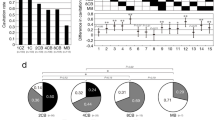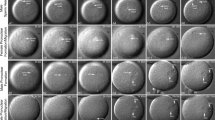Abstract
Despite an apparent lack of determinants that specify cell fate, spatial patterning of the mouse embryo is evident early in development. The axis of the post-implantation egg cylinder can be traced back to organization of the pre-implantation blastocyst1. This in turn reflects the organization of the cleavage-stage embryo and the animal–vegetal axis of the zygote2,3. These findings suggest that the cleavage pattern of normal development may be involved in specifying the future embryonic axis; however, how and when this pattern becomes established is unclear. In many animal eggs, the sperm entry position provides a cue for embryonic patterning4,5,6, but until now no such role has been found in mammals. Here we show that the sperm entry position predicts the plane of initial cleavage of the mouse egg and can define embryonic and abembryonic halves of the future blastocyst. In addition, the cell inheriting the sperm entry position acquires a division advantage and tends to cleave ahead of its sister. As cell identity reflects the timing of the early cleavages, these events together shape the blastocyst whose organization will become translated into axial patterning after implantation. We present a model for axial development that accommodates these findings with the regulative nature of mouse embryos.
This is a preview of subscription content, access via your institution
Access options
Subscribe to this journal
Receive 51 print issues and online access
$199.00 per year
only $3.90 per issue
Buy this article
- Purchase on Springer Link
- Instant access to full article PDF
Prices may be subject to local taxes which are calculated during checkout






Similar content being viewed by others
References
Weber, R. J., Pedersen, R. A., Wianny, F., Evans, M. J. & Zernicka-Goetz, M. Polarity of the mouse embryo is anticipated before implantation. Development 126 , 5591–5598 (1999).
Ciemerych, M. A., Mesnard, D. & Zernicka-Goetz, M. Animal and vegetal poles of the mouse egg predict the polarity of the embryonic axis, yet are non-essential for development. Development 127, 3467–3474 (2000).
Gardner, R. L. The early blastocyst is bilaterally symmetrical and its axis of symmetry is aligned with the animal–vegetal axis of the zygote in the mouse. Development 124, 289–301 (1997).
Goldstein, B. & Hird, S. N. Specification of the anteroposterior axis in Caenorhabditis elegans. Development 122, 1467–1474 (1996).
Bowerman, B. in Cell Lineage and Fate Determination (ed. Moody, S. A.) 97– 117 (Academic, San Diego, 1999).
Gerhart, J. et al. Cortical rotation of the Xenopus egg: consequences for the anteroposterior pattern of embryonic dorsal development. Development 107, 37–51 ( 1989).
Graham, C. F. & Deussen, Z. A. Features of cell lineage in preimplantation mouse development. J. Embryol. Exp. Morphol. 48 , 53–72 (1978).
Kelly, S. J., Mulnard, J. G. & Graham, C. F. Cell division and cell allocation in early mouse development. J. Embryol. Exp. Morphol. 48, 37–51 (1978).
Tarkowski, A. K. & Wroblewska, J. Development of blastomeres of mouse eggs isolated at the 4- and 8-cell stage. J. Embryol. Exp. Morphol. 18, 155– 180 (1967).
Rossant, J. Postimplantation development of blastomeres isolated from 4- and 8-cell mouse eggs. J. Embryol. Exp. Morphol. 36, 283–290 (1976).
Balakier, H. & Pedersen, R. A. Allocation of cells to inner cell mass and trophectoderm lineages in preimplantation mouse embryos. Dev. Biol. 23, 52–62 ( 1982).
Surani, M. A. & Barton, S. C. Spatial distribution of blastomeres is dependent on cell division order and interactions in mouse morulae. Dev. Biol. 102, 335–343 (1984).
Garbutt, C. L., Johnson, M. H. & George, M. A. When and how does cell division order influence cell allocation to the inner cell mass of the mouse blastocyst? Development 100, 325–332 ( 1987).
Graham, C. F. & Lehtonen, E. Formation and consequences of cell patterns in preimplantation mouse development. J. Embryol. Exp. Morphol. 49, 277–294 ( 1979).
Garbutt, C. L., Chisholm, J. C. & Johnson, M. H. The establishment of the embryonic–abembryonic axis in the mouse embryo. Development 100, 125–134 (1987).
Copp, A. J. Interaction between inner cell mass and trophectoderm of the mouse blastocyst. II. The fate of the polar trophectoderm. J. Embryol. Exp. Morphol. 51, 109–120 ( 1979).
Cruz, Y. P & Pedersen, R. A. Cell fate in the polar trophectoderm of mouse blastocysts as studied by microinjection of cell lineage tracers. Dev. Biol. 112, 73–83 (1985).
Gardner, R. L. Clonal analysis of growth of the polar trophectoderm in the mouse. Hum. Reprod. 11, 1979–1984 (1996).
Zernicka-Goetz, M. Fertile offspring derived from mammalian eggs lacking either animal or vegetal poles. Development 125, 4803– 4808 (1998).
Acknowledgements
We are grateful to D. Glover for invaluable suggestions and support; R. Pedersen and C. Graham for helpful discussions; and J. Gurdon for his critical comments. This work was supported by a Lister Institute of Preventive Medicine Fellowship, a Wellcome Trust Project Grant and a Royal Society Equipment Grant to M.Z.-G.
Author information
Authors and Affiliations
Corresponding author
Rights and permissions
About this article
Cite this article
Piotrowska, K., Zernicka-Goetz, M. Role for sperm in spatial patterning of the early mouse embryo. Nature 409, 517–521 (2001). https://doi.org/10.1038/35054069
Received:
Accepted:
Issue Date:
DOI: https://doi.org/10.1038/35054069
Comments
By submitting a comment you agree to abide by our Terms and Community Guidelines. If you find something abusive or that does not comply with our terms or guidelines please flag it as inappropriate.



